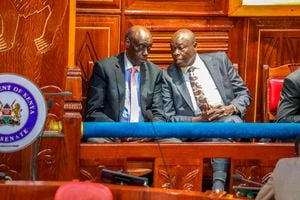Sexual harassment: Why male journalists suffer in silence

Although male journalists are the victims of sexual harassment, their attitude and perception toward it makes it hard to break the cycle.
What you need to know:
- Globally, 30 percent of media professionals have been victims of either verbal or physical sexual harassment.
- There is need to create safe spaces in the newsrooms for the men to open up.
- A study shows that 96 per cent male journalists say they had been harassed by either female colleagues and news sources or both.
Sexual harassment in the media has often been described as a monster. It has pushed journalists into depression while others opted out into other professions, especially public relations and academia.
Globally, 30 per cent of media professionals have been victims of either verbal or physical sexual harassment going by 2022 World Association of Newspapers and News Publishers (WAN-IFRA) Women in News and City, University of London data.
When broken down, 12 per cent of men are found to have suffered one or both forms of sexual harassment.
To find out just how monstrous this crime is prevalent among the male journalists in the Kenyan media, this writer set out to speak with some.
Between April 8 and April 14, she interviewed 17 male journalists from three major media houses.
Their responses were heart-breaking, but still pointed to the need to create safe spaces in the newsrooms for the men to open up. Sensitization on what it means to be sexually harassed and why they should not normalise the crime is also necessary.
Physical violence
As per the definition of International Labour Organisation, sexual harassment is as a sex-based behaviour that is unwelcome and offensive to its recipient. For sexual harassment to exist these two conditions must be present, it says.
It can be physical in the form of physical violence, touching and unnecessary close proximity. It is also manifested verbally through comments and questions about appearance, lifestyle, sexual orientation, and offensive phone calls.
At the same time, when an individual whistles at another or makes sexually-suggestive gestures and displays sexual materials, he or she is committing the crime.
In Kenya, under Clause 23(1) of Sexual Offences Act (2006) sexual harassment is punishable with not less than three years imprisonment or a fine of Sh100,000.
But the offence is when a person of authority or holding a public office persistently “makes any sexual advances or requests, which he or she knows, or has reasonable grounds to know are unwelcome”, according to the Act.
The sampled journalists were asked whether they have been sexually harassed by a colleague, editor or media manager in the newsroom. They were also questioned on whether they have encountered the same from news sources.
Sexual comments
Of the 17, only one would clearly describe the ways in which the crime can be committed. He has, however, faced neither.
The 16 just mentioned touching, making sexual comments, demands for sexual favours and asking about sexual orientation as means in which one can be considered to have been sexually harassed by female or male colleagues.
Interestingly, only three said they had not been harassed although one argued that “that also depends on my perception. Somebody may have harassed me but I don’t consider that as harassment.”
Ninety-six per cent said they had been harassed by either female colleagues and news sources or both.
Three per cent cited only female news sources as their perpetrators, while for one per cent, it was a male colleague.
The journalist said the male colleague asked him whether he preferred to have relationships with men or women.
“He later started making comments like ‘I smell good’ or commending me for dressing well. This went on for a while until I changed the route to my desk,” he confessed.
Four said they have been harassed through provocative dressing by female colleagues even though this does not constitute sexual harassment based on the existing definitions.
“They wear short skirts and clothes that expose their cleavage. Then they come and sit on top of your desk. That is harassment. We are really suffering. That affects me psychologically and physically,” one said.
A Nakuru-based reporter shared a harrowing experience in the hands of a female news source.
“In 2020, I had covered a court case in which a certain businesswoman was one of the parties. She got my contact and from then on, she would inform me when the case was coming up in court,” he started off the narration.
“Some months later, he started calling me even at night and the conversations were no longer professional. She began seducing me but I would put her off. But she persisted. It was too much till I felt like she was throwing me into depression cell. I finally blocked her and gave up with the case.”
But then, he didn’t share his distress with his immediate supervisor and I asked him why.
His response was: “How do you even start. I may be accused of having started it or allowed it to happen.”
Another Nakuru photojournalist said he has, on several occasions, been a victim. All his perpetrators are female politicians in their 40s and above.
Worst of all, he said, they intimidated him to submit to their sexual advances. They claimed they are related or friends with the media managers in his media house.
“I felt ashamed when they would introduce me to their colleagues as a journalist ‘who has served her well,’ which to me implied that she meant I had slept with her yet I had not,” he said.
He later stopped covering their events. He, just like the earlier reporter, did not mention his ordeal to his supervisor for a similar reason.
“You just console yourself you’re a man and those are things that should not worry you. And you move on with life. But it can be very disturbing considering that I am married,” he said.
In Kenya, men make up the near 100 per cent of print and electronic reporters, based on data from Global Media Monitoring Project 2020 report by World Association for Christian Communication.
For instance 92 per cent of the male journalists in newspapers, television and radio report on politics and government as well as crime and violence, compared to eight per cent of women.
They also take the largest share in science and health docket (80 per cent) against 20 per cent of the female journalists.
Considering that the majority of the sampled journalists cited news sources as major perpetrators, thereby implies that more male journalists are at risk of sexual harassment outside the newsroom than their female colleagues.
Unfortunately, although the male journalists are the victims, their attitude and perception toward sexual harassment can even make it hard to break the cycle.
One said: “There is one female colleague who tickled my palm and I tickled her back. She started it. You just enjoy it.”
And Kenya Union of Journalists (KUJ) Secretary-General Eric Oduor affirms that some male journalists indeed take advantage of the provocation.
“For now, when we receive the complaints, we forward them to the media houses to address them internally,” said Mr Oduor in response to how KUJ is tackling this menace.
“But the media houses are very slow in addressing them,” he added.
His assertion is reaffirmed by 2022 WAN-IFRA, Women in News and City, University of London’s study.
The researchers interviewed 575 media professionals (including men) from Botswana, Kenya, Malawi, Rwanda, Tanzania, Uganda, Zambia and Zimbabwe.
Maanzoni declaration
They found that one in two has faced sexual harassment at work.
About 56 per cent experienced verbal harassment and 38 per cent, physical.
Nevertheless, only 21 reported the crimes and 57 per cent of the time their media organisations took action.
Last year, a Kenya Media Sector Working Group meeting at Maanzoni Lodge in Machakos County, resulted in 13 resolutions dubbed “Maanzoni declaration.”
The 10th resolution calls for affirmative action to ensure more women are not only recruited, but given equal opportunities at the workplace.
Further, the 11th resolution demands “that a sector-wide intervention to address any sexual harassment within the media space be urgently undertaken.”
Already, Association of Media Women in Kenya, which alongside KUJ and other media associations constitutes the working group, heads an ad hoc committee on anti-sexual harassment in the media. The committee’s work is to strategise on sustainable ways of tackling the plague.
Mr Oduor said soon the committee would be naming and shaming the perpetrators.
Media Council of Kenya (MCK), the statutory body which regulates the media and conduct of journalists is also involved in advocating against the vice.
“We encourage an all-inclusive approach to do away with the perception that it is a women's problem,” said Dinnah Ondari, MCK manager for press freedom, safety and advocacy.
She said, men are not bothered by sexual harassment because “men are not affected in large numbers and, therefore, they don’t see it as an issue.”
There is also a “general lack of awareness on their role in being part of the solution,” she said.
She, however, said interventions such as sensitisation, assisting media houses to set up policies that promote a conducive working environment for their staff, as well as trainings based on MCK gender curriculum, can help in eliminating the monster from the newsrooms.
This story was supported by Code for Africa’s Wanadata initiative





